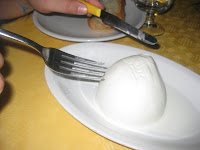A Greek salad is a popular salad within the Greek cuisine. It is known in Greek as a Horiatiki Salata. It is made with tomatoes, cucumbers, green peppers, red onion, feta cheese, kalamata olives, and spiced with salt, pepper, and oregano dressed with olive oil. Every salad I got in Greece though was different. Some had lettuce or didn't have kalamata olives and green peppers. They were also spiced differently. Although they were all different, they were delicious.
I do not like cheese, but I like Feta cheese. This cheese is traditionally made in Greece. It is a brined curd cheese made from sheep's milk, or from a mixture of sheep's and goat's milk. Feta is an aged crumbly cheese with a grainy texture. It is used sometimes as a table cheese with crackers, tossed in salads such as a Greek salad, used as a filling in pastries like Spinach pie, and can be served cooked to make Saganaki flaming cheese.
I had my Greek Salad served with Souvlaki chicken, which are small pieces of meat grilled on a skewer. You can get this style of meat on a dinner plate with vegetables or potatoes, in a pita sandwich, or with sauces. I just got the plain skewer of chicken and added the pieces to my salad. To top off the salad, I got a grilled seasoned pita with tziki sauce on the side.
I loved the Greek cuisine and am really craving a Greek Salad now....
























